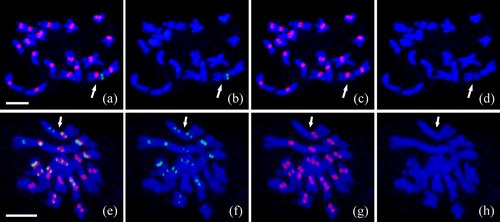The centromere is a specialized chromatin domain present throughout the cell cycle that acts as a platform on which the transient assembly of the kinetochore occurs, which mediates chromosome orientation and segregation during mitosis and meiosis. Several lines of research indicate that centromere specification is epigenetically determined. The prime candidate for an epigenetic mark that specifies centromere identity is the centromere-specific histone H3 variant-CENH3 (CENP-A in human).
To gain insight into the epigenetic identity of the centromere, Dr. Fangpu Han’s group from the Institute of Genetics and Developmental Biology at the Chinese Academy of Sciences carried out extensive research on histone modifications in maize and found that histone H2A phosphorylation is associated with centromere function and maintenance. Immunostaining results indicate that ph-H2A-Thr133 signals colocalize with CENH3, and H2A-Thr133 is phosphorylated in different cell types in a cell-cycle dependent process. Immunostaining of several maize dicentric chromosomes revealed that the inactive centromeres had lost the phosphorylation of H2A-Thr133. In order to study the function of histone H2A phosphorylation, two maize meiotic mutants afd1 and sgo1, which have cohesion altered at metaphase I and metaphase II, were used. These mutants indicate that the signals for histone H2A phosphorylation are not dependent on cohesion but on centromere activity.
This work with Dr. Qianhua Dong as the first author has been online published in The Plant Journal (DOI: 10.1111/j.1365-313X.2012.05029.x). This research was supported by grants from National Basic Research Program of China, National Natural Science Foundation of China, and Knowledge Innovation Program of the Chinese Academy of Sciences.
AUTHOR CONTACT:
Fangpu Han, Ph.D.
Institute of Genetics and Developmetnal Biology, Chinese Academy of Sciences, Beijing, China.
(Image by Dong Qianhua et al.)
Figure. Immunolocalization analysis of H2A-phThr133 in Dicentric 9Bic-1 and T1-5 somatic chromosomes. (a-d) 9Bic-1 is a dicentric chromosome in which the B centromere was translocated onto the tip of the short arm of chromosome 9 and inactive. (e-h) T1-5 is a translocation chromosome involving maize chromosomes 1 and 5 with one centromere inactive. Ph-H2A-Thr133 signals are red; DAPI stained chromosomes are blue; B-repeat (a-d) and CentC (e-h) are green. Arrows indicate the dicentric chromosomes. Bar =10 μm.
 (Image by Dong Qianhua et al.)Figure. Immunolocalization analysis of H2A-phThr133 in Dicentric 9Bic-1 and T1-5 somatic chromosomes. (a-d) 9Bic-1 is a dicentric chromosome in which the B centromere was translocated onto the tip of the short arm of chromosome 9 and inactive. (e-h) T1-5 is a translocation chromosome involving maize chromosomes 1 and 5 with one centromere inactive. Ph-H2A-Thr133 signals are red; DAPI stained chromosomes are blue; B-repeat (a-d) and CentC (e-h) are green. Arrows indicate the dicentric chromosomes. Bar =10 μm.
(Image by Dong Qianhua et al.)Figure. Immunolocalization analysis of H2A-phThr133 in Dicentric 9Bic-1 and T1-5 somatic chromosomes. (a-d) 9Bic-1 is a dicentric chromosome in which the B centromere was translocated onto the tip of the short arm of chromosome 9 and inactive. (e-h) T1-5 is a translocation chromosome involving maize chromosomes 1 and 5 with one centromere inactive. Ph-H2A-Thr133 signals are red; DAPI stained chromosomes are blue; B-repeat (a-d) and CentC (e-h) are green. Arrows indicate the dicentric chromosomes. Bar =10 μm. CAS
CAS
 中文
中文




.png)
